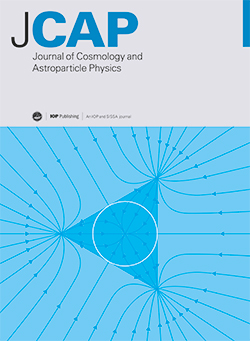Constraining ultra slow roll inflation using cosmological datasets
IF 5.3
2区 物理与天体物理
Q1 ASTRONOMY & ASTROPHYSICS
Journal of Cosmology and Astroparticle Physics
Pub Date : 2024-07-30
DOI:10.1088/1475-7516/2024/07/088
引用次数: 0
Abstract
In recent years, the detection of gravitational waves by LIGO and PTA collaborations have raised the intriguing possibility of excess matter power at small scales. Such an increase can be achieved by ultra slow roll (USR) phase during inflationary epoch. We constrain excess power over small scales within the framework of such models using cosmological datasets, particularly of CMB anisotropies and Lyman-α. We parameterize the USR phase in terms of the e-fold at the onset of USR (counted from the end of inflation) N̅1 and the duration of USR phase Δ N. The former dictates the scale of enhancement in the primordial power spectrum, while the latter determines the amplitude of such an enhancement. From a joint dataset of CMB and galaxy surveys, we obtain N̅1 ≲ 45 with no bound on Δ N. This in turn implies that the scales over which the power spectrum can deviate significantly from the nearly scale invariant behavior of a typical slow-roll model is k ≳1 Mpc-1. On the other hand, the Lyman-α data is sensitive to baryonic power spectrum along the line of sight. We consider a semi-analytic theoretical method and high spectral-resolution Lyman-α data to constrain the model. The Lyman-α data limits both the USR parameters: N̅1 ≲ 41 and Δ N ≲ 0.4. This constrains the amplitude of the power spectrum enhancement to be less than a factor of hundred over scales 1 ≲ k/ Mpc-1≲ 100, thereby considerably improving the constraint on power over these scales as compared to the bounds arrived at from CMB spectral distortion.利用宇宙学数据集制约超慢速滚动膨胀
近年来,LIGO 和 PTA 合作组织对引力波的探测提出了一种令人感兴趣的可能性,即在小尺度上存在过剩的物质能量。这种增加可能是在暴胀时代的超慢滚(USR)阶段实现的。我们利用宇宙学数据集,特别是 CMB 各向异性和莱曼-α 数据集,在这类模型的框架内对小尺度的过剩能量进行了约束。前者决定了原始功率谱增强的尺度,后者决定了这种增强的幅度。我们从 CMB 和星系巡天的联合数据集中得到 N̅1 ≲ 45,对 Δ N 没有约束。这反过来意味着,功率谱与典型慢速滚动模型的近乎尺度不变行为发生显著偏差的尺度是 k ≳1 Mpc-1。另一方面,莱曼-α 数据对沿视线方向的重子功率谱很敏感。我们考虑用半解析理论方法和高光谱分辨率的 Lyman-α 数据来约束模型。莱曼-α数据限制了USR参数:N̅1 ≲41,Δ N ≲0.4。这就限制了功率谱增强的幅度在 1 ≲ k/ Mpc-1≲ 100 尺度上小于百倍,从而大大改进了这些尺度上对功率的限制,而不是根据 CMB 光谱畸变得出的界限。
本文章由计算机程序翻译,如有差异,请以英文原文为准。
求助全文
约1分钟内获得全文
求助全文
来源期刊

Journal of Cosmology and Astroparticle Physics
地学天文-天文与天体物理
CiteScore
10.20
自引率
23.40%
发文量
632
审稿时长
1 months
期刊介绍:
Journal of Cosmology and Astroparticle Physics (JCAP) encompasses theoretical, observational and experimental areas as well as computation and simulation. The journal covers the latest developments in the theory of all fundamental interactions and their cosmological implications (e.g. M-theory and cosmology, brane cosmology). JCAP''s coverage also includes topics such as formation, dynamics and clustering of galaxies, pre-galactic star formation, x-ray astronomy, radio astronomy, gravitational lensing, active galactic nuclei, intergalactic and interstellar matter.
文献相关原料
| 公司名称 | 产品信息 | 采购帮参考价格 |
|---|
 求助内容:
求助内容: 应助结果提醒方式:
应助结果提醒方式:


